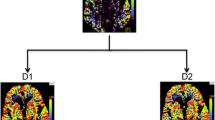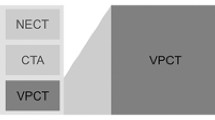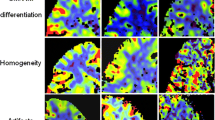Abstract
Purpose
To examine the influence of radiation dose reduction on image quality and sensitivity of Volume Perfusion CT (VPCT) maps regarding the detection of ischemic brain lesions.
Methods and materials
VPCT data of 20 patients with suspected ischemic stroke acquired at 80 kV and 180 mAs were included. Using realistic reduced-dose simulation, low-dose VPCT datasets with 144 mAs, 108 mAs, 72 mAs and 36 mAs (80 %, 60 %, 40 % and 20 % of the original levels) were generated, resulting in a total of 100 datasets. Perfusion maps were created and signal-to-noise-ratio (SNR) measurements were performed. Qualitative analyses were conducted by two blinded readers, who also assessed the presence/absence of ischemic lesions and scored CBV and CBF maps using a modified ASPECTS-score.
Results
SNR of all low-dose datasets were significantly lower than those of the original datasets (p < .05). All datasets down to 72 mAs (40 %) yielded sufficient image quality and high sensitivity with excellent inter-observer-agreements, whereas 36 mAs datasets (20 %) yielded poor image quality in 15 % of the cases with lower sensitivity and inter-observer-agreements.
Conclusion
Low-dose VPCT using decreased tube currents down to 72 mAs (40 % of original radiation dose) produces sufficient perfusion maps for the detection of ischemic brain lesions.
Key Points
• Perfusion CT is highly accurate for the detection of ischemic brain lesions
• Perfusion CT results in high radiation exposure, therefore low-dose protocols are required
• Reduction of tube current down to 72 mAs produces sufficient perfusion maps





Similar content being viewed by others
Change history
29 September 2017
An erratum to this article has been published.
Abbreviations
- ACA:
-
Anterior cerebral artery
- CBF:
-
Cerebral blood flow
- CBV:
-
Cerebral blood volume
- LD VPCT:
-
Low-dose volume perfusion CT
- MCA:
-
Middle cerebral artery
- MTT:
-
Mean transit time
- NVT:
-
Nonviable tissue
- PCA:
-
Posterior cerebral artery
- ROI:
-
Region of interest
- SD:
-
Standard deviation
- SNR:
-
Signal-to-noise-ratio
- TAR:
-
Tissue at risk
- TTD:
-
Time-to-drain
- TTP:
-
Time-to-peak
- VPCT:
-
Volume perfusion CT
References
Kloska SP, Nabavi DG, Gaus C et al (2004) Acute stroke assessment with CT: do we need multimodal evaluation? Radiology 233:79–86
Wintermark M, Fischbein NJ, Smith WS, Ko NU, Quist M, Dillon WP (2005) Accuracy of dynamic perfusion CT with deconvolution in detecting acute hemispheric stroke. AJNR Am J Neuroradiol 26:104–112
Lin K, Do KG, Ong P et al (2009) Perfusion CT improves diagnostic accuracy for hyperacute ischemic stroke in the 3-hour window: study of 100 patients with diffusion MRI confirmation. Cerebrovasc Dis 28:72–79
Mnyusiwalla A, Aviv RI, Symons SP (2009) Radiation dose from multidetector row CT imaging for acute stroke. Neuroradiology 51:635–640
Wintermark M, Lev MH (2010) FDA investigates the safety of brain perfusion CT. AJNR Am J Neuroradiol 31:2–3
Wiesmann M, Berg S, Bohner G et al (2008) Dose reduction in dynamic perfusion CT of the brain: effects of the scan frequency on measurements of cerebral blood flow, cerebral blood volume, and mean transit time. Eur Radiol 18:2967–2974
Abels B, Klotz E, Tomandl BF, Villablanca JP, Kloska SP, Lell MM (2011) CT perfusion in acute ischemic stroke: a comparison of 2-second and 1-second temporal resolution. AJNR Am J Neuroradiol 32:1632–1639
Wintermark M, Maeder P, Verdun FR et al (2000) Using 80 kVp versus 120 kVp in perfusion CT measurement of regional cerebral blood flow. AJNR Am J Neuroradiol 21:1881–1884
Li ZL, Li H, Zhang K et al (2014) Improvement of image quality and radiation dose of CT perfusion of the brain by means of low-tube voltage (70 KV). Eur Radiol 24:1906–1913
Niesten JM, van der Schaaf IC, Riordan AJ et al (2014) Radiation dose reduction in cerebral CT perfusion imaging using iterative reconstruction. Eur Radiol 24:484–493
Juluru K, Shih JC, Raj A et al (2013) Effects of increased image noise on image quality and quantitative interpretation in brain CT perfusion. AJNR Am J Neuroradiol 34:1506–1512
Yang DH, Goo HW (2008) Pediatric 16-slice CT protocols: radiation dose and image quality. J Korean Radiol Soc 59:333–347
Won Kim C, Kim JH (2014) Realistic simulation of reduced-dose CT with noise modeling and sinogram synthesis using DICOM CT images. Med Phys 41:011901
Pexman JH, Barber PA, Hill MD et al (2001) Use of the Alberta Stroke Program Early CT Score (ASPECTS) for assessing CT scans in patients with acute stroke. AJNR Am J Neuroradiol 22:1534–1542
Pham M, Johnson A, Bartsch AJ et al (2007) CT perfusion predicts secondary cerebral infarction after aneurysmal subarachnoid hemorrhage. Neurology 69:762–765
Wintermark M, Ko NU, Smith WS, Liu S, Higashida RT, Dillon WP (2006) Vasospasm after subarachnoid hemorrhage: utility of perfusion CT and CT angiography on diagnosis and management. AJNR Am J Neuroradiol 27:26–34
Dankbaar JW, de Rooij NK, Rijsdijk M et al (2010) Diagnostic threshold values of cerebral perfusion measured with computed tomography for delayed cerebral ischemia after aneurysmal subarachnoid hemorrhage. Stroke 41:1927–1932
van der Schaaf I, Wermer MJ, van der Graaf Y, Hoff RG, Rinkel GJ, Velthuis BK (2006) CT after subarachnoid hemorrhage: relation of cerebral perfusion to delayed cerebral ischemia. Neurology 66:1533–1538
Sandborg M, Althén JN, Pettersson H, Rossitti S (2012) Patient organ radiation doses during treatment for aneurysmal subarachnoid hemorrhage. Clin Neuroradiol 22:315–325, 1869–1439
Acknowledgments
The scientific guarantor of this publication is Professor Dr. Martin Wiesmann. The authors of this manuscript declare no relationships with any companies, whose products or services may be related to the subject matter of the article. The authors state that this work has not received any funding. One of the authors (Ahmed Othman) has significant statistical expertise. Institutional Review Board approval was received and the Institutional Review Board waived the requirement for informed patient consent. Approval from the institutional animal care committee was not required because the study was conducted on Patient data. Methodology: retrospective, diagnostic or prognostic, multicenter study.
Author information
Authors and Affiliations
Corresponding author
Additional information
An erratum to this article is available at https://doi.org/10.1007/s00330-017-5009-3.
Electronic supplementary material
Below is the link to the electronic supplementary material.
Fig. S1
A schematic diagram provides an overview of realistic reduced-dose simulation technique used in this study. (GIF 16 kb)
High Resolution Image
(TIFF 152 kb)
Appendix
Appendix
Overview of the realistic reduced-dose simulation technique
Realism of added noise pattern in low dose CT simulation depends on two key characteristics of CT systems; the noise equivalent quanta (NEQ) and the algorithmic modulation transfer function (MTF). The NEQ determines the magnitude of noise whereas MTF shapes noise texture. In addition, the presence of highly attenuating objects in the image causes streak noise patterns due to photon starvation phenomenon. Usually, CT raw sinogram data along with a vendor provided noise simulation tool were required to generate simulated low dose CT images, which appropriately reflect those system characteristics. However, it takes great effort and is often unrealizable in many institutions. Our study instead used a novel realistic reduced-dose CT simulation method using only DICOM images based on noise modeling and sinogram synthesis techniques. The overall procedure is illustrated in Fig. S1.
This method uses a comprehensive CT noise model, which employs the NEQ and MTF of the CT system and reflects the reduced x-ray photon flux, object attenuation, system noise, and bow-tie filter. This comprehensive CT noise model enabled generation of appropriate magnitudes and textures of noise without needing to have vendor support.
In addition, this method generates a synthetic sinogram using a DICOM CT image, which is in turn used to produce a simulated noise sinogram for the reduced-dose condition. The magnitude of noise was determined on a pixel-by-pixel basis by taking into account the combined effect of the reduced photon flux, attenuation sum of the object along the ray path, and the system noise arising from the detector circuit. This simulated noise sinogram was then filtered with the algorithmic MTF of the reconstruction kernel and back-projected to create a simulated noise CT image. This simulated noise CT image contain appropriate noise magnitude and texture as well as attenuation-dependent streak patterns. Finally, this noise CT image was then added to the DICOM CT image, finally providing a realistic simulated reduced-dose CT image. This method was validated with a phantom study, which showed that the power spectrum of real and simulated low dose CT were indistinguishable from each other statistically at 12 different combinations of object size, tube current, and reconstruction kernels.
Rights and permissions
About this article
Cite this article
Othman, A.E., Brockmann, C., Yang, Z. et al. Effects of radiation dose reduction in Volume Perfusion CT imaging of acute ischemic stroke. Eur Radiol 25, 3415–3422 (2015). https://doi.org/10.1007/s00330-015-3763-7
Received:
Revised:
Accepted:
Published:
Issue Date:
DOI: https://doi.org/10.1007/s00330-015-3763-7




